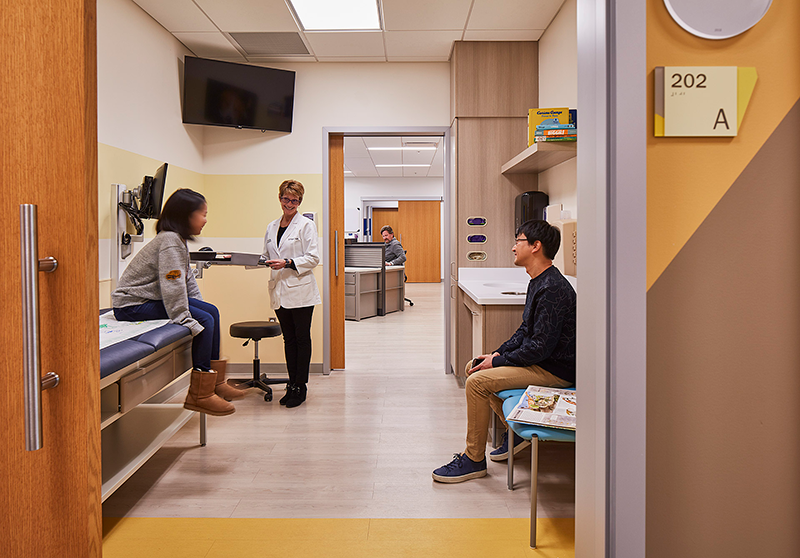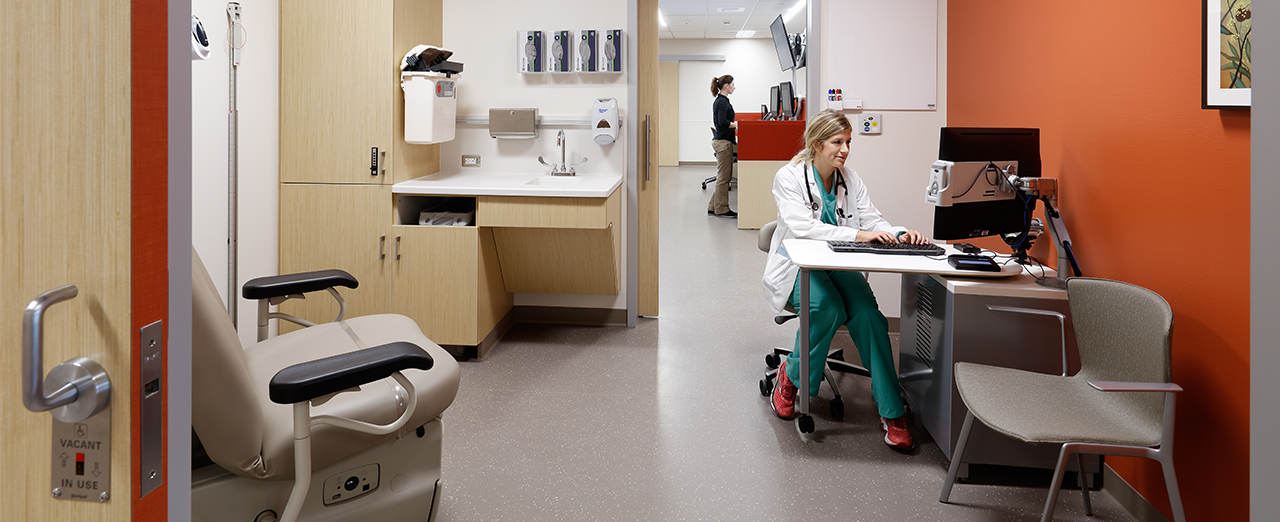
To explain how sliding doors can improve exam rooms and healthcare facilities, Tysen Gannon, LEED AP, speaks to four important considerations in the Q+A below.
Q. How can exam room sliding doors help care teams use space as efficiently as possible?
A. Sliding door systems dedicate less usable space to door swings and approach clearances, meaning more square footage can be used directly for patient care. Sliding medical exam doors also provide more room for seating and furnishing, cabinets, mobile workstations and other essential items.
Further, these doors allow designers and facility managers to create optimally sized facilities from the start of a project. This can translate to more exam rooms or other functional spaces in a project, improving the overall efficiency of healthcare services and operations.
Q. What primary advantages do sliding door systems provide from a patient’s perspective?
A. Sliding doors can contribute to the overall efficiency of a facility, which has trickle down benefits for patients. Not only does this mean care teams can move through rooms and hallways with ease but also the space-saving design of sliding doors can potentially allow for more exam rooms. With increased efficiency, patients may enjoy reduced waiting times to see a provider and have a better experience overall.
When it comes to direct interaction, sliding doors, in many cases, can be easier to operate for those using assistive devices because they do not need to “push through” a swing door or get out of the way of an in-swinging door as it opens. This in conjunction with easily used hardware helps sliding doors in exam rooms support designs that are accessible for all.
Q. What role does the Americans with Disabilities Act (ADA) play in the design and use of medical exam room doors?
A. Addressing the mobility needs of a wide range of users is critically important, particularly in healthcare facilities. The ADA outlines the requirements for designing and constructing accessible spaces and affects: opening size, approach clearances and hardware placement and operation.
For medical exam room doors, opening size and approach clearances are particularly important. Because these rooms are generally small and must incorporate exam tables, cabinets, workstations and seating, design teams often face the challenge of fitting everything into the room while leaving enough space to move around freely. Because sliding doors can save up to 30 square feet per door, they can help designers meet ADA requirements more easily than traditional swing doors.
Q. What new advances in sliding door design are particularly beneficial to exam rooms and healthcare facilities?
A. Sliding doors have improved dramatically in terms of what they can offer when it comes to acoustic performance. Sliders with drop-down bottom seals and gaskets now make it possible to seal all four sides of the door leaf in the closed position, giving sliding doors with these features an NIC rating of up 39, which meets industry standards. Acoustically rated medical exam doors mean greater patient privacy and a more comfortable patient experience. Sliding doors are now also able to offer life safety options such as fire ratings and smoke ratings that allow them to be used in expanded areas of facilities or in areas where pressurization is required (i.e. isolation rooms).
High-quality commercial grade hardware that is robust and easy to use is also now a current mainstay of exam room sliding door design. This hardware not only meets or exceeds ADA requirements but also contributes to better user experience. Finally advanced features, such as automation, bring patients and providers the highest levels of accessibility and infection control, even offering “hands free” operation.
Sliding doors meet heightened needs
Designing with the end-user in mind can have a profound impact on a space’s ability to satisfy the needs of its occupants. While this sentiment is true for all buildings, it is especially relevant to healthcare facilities, where a well-designed facility can potentially influence patient outcomes. Exam room sliding doors can help designers maximize useable space and improve efficiency throughout a building to help care teams provide the best care to their patients.







